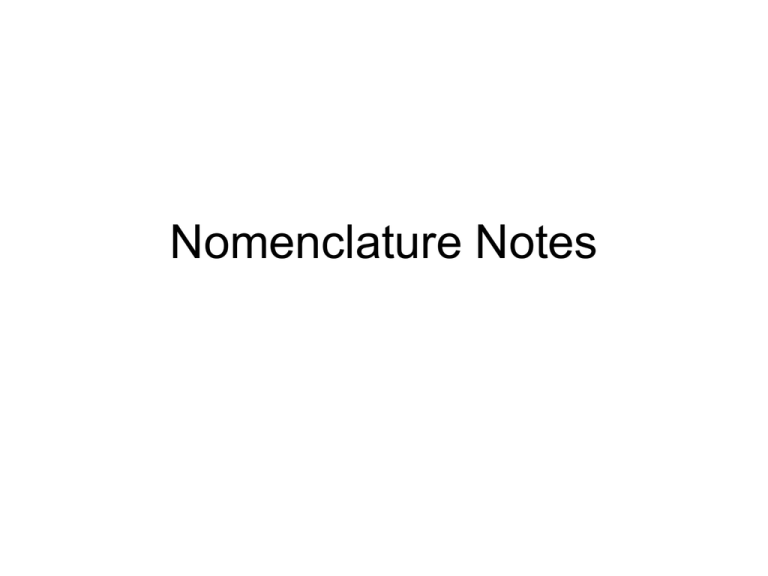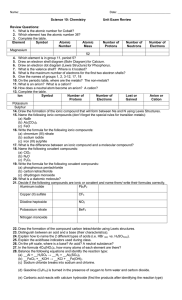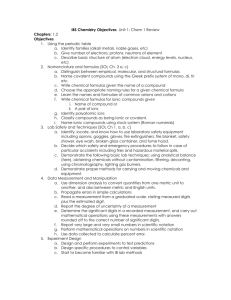Nomenclature Notes
advertisement

Nomenclature Notes Naming compounds • Two types • Ionic - metal and non metal or polyatomics. • Covalent- we will just learn the rules for 2 non-metals. Ionic compounds • If the cation is monoatomic- Name the metal (cation) just write the name. • If the cation is polyatomic- name it. • If the anion is monoatomic- name it but change the ending to –ide. • If the anion is poly atomic- just name it • Practice. Covalent compounds • Two words, with prefixes. • Prefixes tell you how many. • mono, di, tri, tetra, penta, hexa, septa, nona, deca • First element whole name with the appropriate prefix, except mono. • Second element, -ide ending with appropriate prefix. • Practice More Naming Ionic compounds • If the cation is monoatomic- Name the metal (cation) just write the name. • If the cation is polyatomic- name it • If the anion is monoatomic- name it but change the ending to -ide • If the anion is poly atomic- just name it • practice Ionic Compounds • • • • Have to know what ions they form off table, polyatomic, or figure it out CaS K2S • AlPO4 • K2SO4 • FeS • CoI3 Ionic Compounds • Fe2(C2O4) • MgO • MnO • KMnO4 • NH4NO3 • Hg2Cl2 • Cr2O3 Ionic Compounds • • • • KClO4 NaClO3 YBrO2 Cr(ClO)6 Naming Covalent Compounds • Two words, with prefixes • Prefixes tell you how many. • mono, di, tri, tetra, penta, hexa, septa, nona, deca • First element whole name with the appropriate prefix, except mono • Second element, -ide ending with appropriate prefix • Practice Naming Covalent Compounds • CO2 • CO • CCl4 • • • • N2O4 XeF6 N4O4 P2O10 Writing Formulas • Two sets of rules, ionic and covalent • To decide which to use, decide what the first word is. • If is a metal or polyatomic use ionic. • If it is a non-metal use covalent. Ionic Formulas • Charges must add up to zero. • Get charges from table, name of metal ion, or memorized from the list. • Use parenthesis to indicate multiple polyatomics. Ionic Formulas • Sodium nitride • sodium- Na is always +1 • nitride - ide tells you it comes from the table • nitride is N-3 Ionic Formulas • Sodium nitride • sodium- Na is always +1 • Nitride - ide tells you it comes from the table • nitride is N-3 • Doesn’t add up to zero. +1 Na -3 N Ionic Formulas • Sodium nitride • sodium- Na is always +1 • nitride - ide tells you it comes from the table • nitride is N-3 • Doesn’t add up to zero +1 -3 • Need 3 Na 3 Na N Na N Ionic Compounds • • • • • • • • Sodium sulfite calcium iodide Lead (II) oxide Lead (IV) oxide Mercury (I) sulfide Barium chromate Aluminum hydrogen sulfate Cerium (IV) nitrite Covalent compounds • The name tells you how to write the formula • duh • Sulfur dioxide • diflourine monoxide • nitrogen trichloride • diphosphorus pentoxide More Names and formulas Acids • Substances that produce H+ ions when dissolved in water. • All acids begin with H. • Two types of acids: • Oxyacids • Non-oxyacids Naming acids • If the formula has oxygen in it • write the name of the anion, but change – ate to -ic acid – ite to -ous acid • Watch out for sulfuric and sulfurous • H2CrO4 • HMnO4 • HNO2 Naming acids • • • • • • If the acid doesn’t have oxygen add the prefix hydrochange the suffix -ide to -ic acid HCl H2S HCN Formulas for acids • Backwards from names. • If it has hydro- in the name it has no oxygen • Anion ends in -ide • No hydro, anion ends in -ate or -ite • Write anion and add enough H to balance the charges. Formulas for acids • • • • • • • hydrofluoric acid dichromic acid carbonic acid hydrophosphoric acid hypofluorous acid perchloric acid phosphorous acid Hydrates • Some salts trap water crystals when they form crystals. • These are hydrates. • Both the name and the formula needs to indicate how many water molecules are trapped. • In the name we add the word hydrate with a prefix that tells us how many water molecules. Hydrates • In the formula you put a dot and then write the number of molecules. • Calcium chloride dihydrate = CaCl22O • Chromium (III) nitrate hexahydrate = Cr(NO3)3 6H2O




